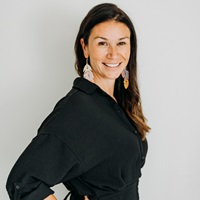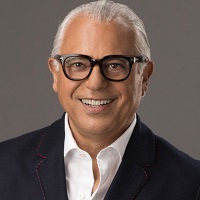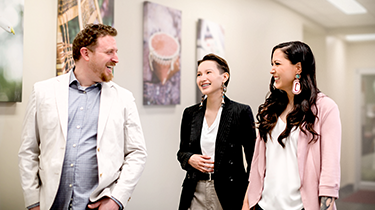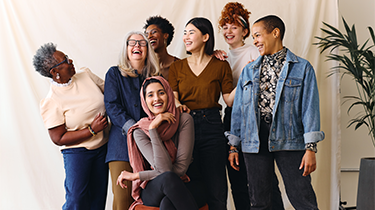
MyEDC gets you the answers you need
Join more than 30,000 Canadians who rely on MyEDC to grow their businesses with confidence.
May 29, 2024

Joe Mimran delves into the remarkable story of MINI TIPI, a Canadian lifestyle brand inspired by Indigenous art, founded by Trisha Pitura and Melanie Bernard in 2016. Pitura shares their journey from a basement startup to a 7,000-square-foot warehouse, reconnecting with her culture and collaborating with Indigenous artists along the way.
Where to listen
Follow us on your favourite streaming platforms to never miss an episode of the Export Impact Podcast. Tune into our podcast for new episodes every second Wednesday at 6 a.m. ET.
Joe Mimran (00:00): Hi, I'm Joe Mimran and welcome back to the Export Impact Podcast. Today, we're exploring the fascinating world of Mini Tipi, a Canadian women-owned company that crafts high-quality goods for your home and family. It was founded in 2016 by Tricia Pitura and Melanie Bernard. Mini Tipi has seen remarkable growth over the years, but what sets it apart? Well, it's not just about exporting goods; it's about embracing an Indigenous perspective from their unique vantage point within Turtle Island, which refers to the continent of North America. Exporting to the United States takes on a whole new meaning.
Today, we'll explore how this perspective shapes Mini Tipi's decision-making process and learn the inspiring story behind their authentic Indigenous accessories brand. Stay tuned as we unravel the remarkable journey of Mini Tipi, a brand that's more than just products; it's a celebration of culture and craftsmanship.
I'd like to begin today's episode by acknowledging that we're recording from my office in Toronto, which is on the traditional unceded territory of many nations, including the Mississaugas of the Credit, the Anishnabeg, the Chippewa, the Haudenosaunee, and the Wendat Peoples, and is now home to many diverse First Nations, Inuit and Metis people. We value taking this moment to deepen the appreciation of our Indigenous communities wherever we are, and to remind ourselves of our shared debt to Canada's First Peoples.
Welcome to the show, Trish.
Trisha Pitura (01:47): Thank you so much, Joe. What an amazing introduction. You nailed it right on the head and thank you so much for having me. It's a great pleasure to be here with you today.
Joe Mimran (01:56): Well, we're going to hear your story. It's really super interesting to me. I'd love to hear, first of all, how you and Melanie met and where the idea for Mini Tipi came from and where did the name come from?
Trisha Pitura (02:11): <laugh> Honestly, our entrepreneurship journey has been quite a ride and to even go back to the beginning and where we have evolved to now is quite an unbelievable story. I’m actually from Sudbury, Ontario and a member of the Nipissing First Nation and I moved to Gatineau, Quebec with my husband to start my family. Melanie and I met at aqua fitness class with our youngest, who were then six months and are now 11 years old. I didn't speak French and she barely spoke any English, but we had big smiles on and body language led us to friendship and we were raising our children at home, becoming mother friends.
I always had a passion for textiles and I was learning to sew. I have an old soul and I'm attracted to a lot of crafts and Melanie has more the marketing side and photography and branding. We naturally came together in a sense of me starting a hobby business in the basement, sewing mostly products for babies. That's how we met in terms of where the business has gone, but we became friends as moms first.
Joe Mimran (03:20): It's interesting how friends can influence each other and how they can support each other on the entrepreneurial journey. It can be a very difficult one, it could be harrowing, it can also be inspiring and exciting and it's full of the unknown as you’re trying to build a business. Perhaps, you can take us through some of the products that you first started with. Like what inspired the first products, what were they and how did that evolve?
Trisha Pitura (03:47): It was in the lifestyle that we were in, raising our children at home. I was making different types of products, like bibs and baby blankets made from mink, like a soft baby blanket. We made all the essentials that a mother might need, but from the very beginning, we were really choosing fabrics. I mostly did that, but Melanie was the one who opened up our Etsy page and our Facebook page. She took pictures—
we were wearing all the hats—in terms of growing our business from our basement.
But we started off with baby products and what really set us apart then was my eye. It's really hard to describe when people ask how do you choose your fabrics, but it's that feeling. I was really attracted to textiles that had a lot to do with nature and florals.
We just set ourselves apart with our products for babies with really unique textiles that were sold at Fabricland. But then we started evolving our business with two different textiles and as I explored new suppliers here in the region or Montreal, I was finding some Indigenous-inspired textile, which was a wool blend, but had more Navajo or native-inspired patterns that were unique. They were interesting and I was attracted to them. We started making blankets and kids’ ponchos with them and women's shawls and that's how we started to evolve to more accessories or home decor with our blankets.
What we really noticed was the lack of authentic Indigenous design in Canada. We're always trying to do better and that's that's our personal values that we're really bringing into our business values is that what can we do better? What's missing? How can we, as a company, bring change? In 2019, we launched our very first exclusive design for Mini Tipi. And that was related as significance to the culture celebrating Indigenous culture. And what really set us apart was the storytelling that we were able to do using textiles.
It was like weaving storytelling into textiles, so that people can either learn from it or reconnect. That was part of my story: Mini Tipi guided me to reconnect to my culture. It was also me connecting with artists and my journey with reconnecting to who I am and allowing Melanie and I to be on that same journey as Melanie's non-Indigenous and I’m Indigenous.
That's where we've led our business—really moving it more out of the baby product as we have evolved and now moving out of our basements into a warehouse and expanding our product development. We also made a supplier change from committing to having only exclusive designs with Mini Tipi, but also changing our supplier to having less impact environmentally; to having a recycled and more eco-sustainable fabric in a wool blend. We are, like I said, constantly looking for what's our impact, how can we change, how can we be better and how can we bring other people along the ride with us?
Joe Mimran (06:44): So, you make your products where?
Trisha Pitura (06:48): All of our products are designed here in Canada. We make blankets, shawls, bags, and kids’ ponchos. We're expanding our product development and all of the designs are in collaboration with Indigenous artists or the house designs that I create. All of our fabric is woven in Italy; all of the wool-blend fabric that we have is imported from Italy, and then in our our 7,000-square-foot warehouse that we've been in for two years with our 10 staff, it’s all cut, sewn, and shipped out of our warehouse into 80 stores across Canada, and in the U.S. we're expanding and also on our online platform.
Joe Mimran (07:29): When you think about the designs that you’re currently creating, is there sort of a historical aspect to them? Where do you get your inspiration from and how did you come to that? Because it sounds like you almost had a self-discovery journey, as well as a business journey.
Trisha Pitura (07:50) That's what I’m grateful for about Mini Tipi. I found my voice or who I am and who I'm more confident telling people I'm Indigenous because of how my grandmother, our culture was taken away and I wasn't proud of who I was. Now, I'm finding my voice and I'm hoping to help other people connect or reconnect and learn. I get emotional a little bit when I talk about that because I've come a long way just to be talking to you <laugh> about it out loud. But I get inspired to learn. I want to learn more. I was exposed to it, but never really taught the meaning behind it or how I can connect and how other people can connect to it. I believe right now, Canada's thirsty to learn and everybody really wants to support Indigenous business, or just understand the culture and where we all came from and where we can all reconnect together.
I feel like when I collaborate with the artists, we provide the platform for them to also express themselves and pass down those teachings that they were taught from their elders or their community. And when they have a designer, when we have an inspiration for a design and collaboration, sometimes our artists take a really traditional artform such as birch-bark biting or traditional quilt making. That's usually done one piece at a time. It takes a lot of time and a lot of craftsmanship and just the amount of work and beauty that goes into that. What we do is kind of modernize it, in a sense. We take those teachings and those traditional artforms and we create it into a textile where it makes it accessible for everyone to learn a little bit about the culture, connect with it, and each one of those designs have a story to tell.
A lot of our feedback from customers—non-Indigenous and Indigenous—is that they have so much connection when they receive that artist card with our product. It has the artist’s name, who they are, what nation they're from, what they do as an artist, but also what that blanket means and why that artist chose to do that design. I feel people connect to our product as part of an experience and we create a conversation where people can learn and talk about it and celebrate the culture and wear it proudly for themselves or whether they're gifting it.
Gift-giving is really strong in Indigenous culture, too, and it has lots of meaning and significance and impact. I feel that when people receive our products, they're grateful for what they received, but also that they can wear it proudly, like I said, but also indigenize fashion and make it part of society as a norm.
Joe Mimran (10:31): And again, when you have these stories, they're so rich, they add so much more to the product than just the product itself. It's a much more appealing gift, I would imagine. How do you vet these artists? How do you find them?
Trisha Pitura (10:47): The beauty of social media—it does have its upsides—is that I use the platform like the Instagram platform and I watch artists and what they're doing in the community and how they're growing. Sometimes, we choose artists who have a really big following or some artists who are just small and starting off. I just reach out to them and I connect with them and we develop a really strong long-term relationship because I want them to trust me. I want them to understand what Mini Tipi does, what we're going to do together. And that goes for all of the partnerships that we create with Mini Tipi is that it doesn't matter what we're doing, it's really important to us that we're building a relationship that when we work together, we're very authentic and we're transparent and they know what we're doing.
We also have all of our designs in terms of IP (intellectual property) protection. We have all of our designs copywritten in the U.S. and in Canada and we're going to eventually expand into Europe. All of these things that we're trying to set up, so that we can build relationships and be leaders, in terms of proper compensation for our artists and with a royalty program that once they develop those relationships with us, they’re long term because as we grow, they also grow.
And it goes full circle, in terms of social impact, because not only are we being recognized as a growing Indigenous entrepreneur or business, but also our artists are being highlighted on our platform or website, or we do videos with them and we talk about what our collaboration looks like. And as we do well and then we grow as a business, like I said, the long term receive royalty payments for all of their designs that they've done with us.
Joe Mimran (12:26): So, it's more than just a blanket; it's a piece of art that people are receiving. Are you encouraging people to use them as wall hangings as well, or are they just being used as a traditional blanket would be used?
Trisha Pitura (12:39): A lot of people have reached out and asked if we have some examples of how they can do it as a wall hanging because you're right, it’s a piece of art. Especially with one artist who we collaborate with, Pat Bruder, a half-moon woman and a traditional birch-bark biter, so when you put up her piece, it's stunning. And then, you have like the history behind that artform and people talk about it when they walk in your house. It's just a really mind-blowing traditional art that she does. I really believe that her pieces are all in museums across Canada, but at the same time, you have a piece in your house hanging on the wall. It's pretty powerful.
A lot of corporations use our blankets as gifts for events. We do get a lot of people reaching out because we can personalize with a brand logo or with a business logo. A lot of people reach out to give meaningful gifts that have some impact socially, as well as economically for people who we work with. But that's another form of how people reach out to us for corporate gifts, as well.
Joe Mimran (13:46): Forgive me, but I'm not familiar with the term “birch-bark biters.”
Trisha Pitura (13:51): For those who are listening, there’s a video on our website under the art about our artists—we do an artist video with all of our artists. That's how we're moving forward with the brand. But it's birch-bark biting. There's the white birch bark, the trees. What you do is you harvest the bark off the tree and then peel it back a layer. And what she does is she folds the thinnest part of the birch bark, and she'll use her eye teeth and in the video, she explains how she's channeling her ancestors and she's just channeling what she wants to do through her. She uses her teeth and creates a design and then when she opens it up, it's symmetrical—you'll have a full design of a dragonfly. On ours, there's bees, there's hearts. She uses her teeth and it's like a snowflake, once you open it up, it's a full design.
I encourage people to go and look at our video because it's pretty powerful and it's been in Indigenous culture for 100s of years. That's how they started with their bead designs. They would create their bead designs in birch bark, but now it's a rare artform that she's trying to bring back and educate people about it. That's how it also comes with our collaboration with Mini Tipi to allow it to be more accessible to everybody.
Joe Mimran (15:12): You've just informed our listeners on what birch-bark biting is. I'm glad I asked that question. Just on the business side of things, you just mentioned Europe. How close are you to selling in Europe? How did you get exposed to Europe? This podcast is about exporting, so our listeners are always curious to understand how you go from being a small business in the basement to a 7,000-square-foot warehouse and all kinds of marketing.
Trisha Pitura (15:42): That's how a lot of our journey started with more import and understanding the ecosystem of supply chain and I shake my head because I also realized from basement to warehouse, but also the daily challenges. I'm not going to say entrepreneurship is easy, but it's the constant learning and trying to learn and wear all the hats as a business owner. You have to learn about the supply chain. You have to figure out about speaking the business language. Expanding in Canada has always been our focus. Canada is huge and we really want to be known as the biggest lifestyle accessory brand, Indigenous brand. We've just cracked in Canada and we have so much more to explore. But we really want to be strategic in our growth and making sure that we're ready.
We’re expanding and exporting into the U.S. and it's been happening organically so far. We've done a few larger trade shows at the One-of-a-kind in Toronto. We did that a couple of years ago before COVID-19 and we met some buyers and it was like, that's how it kind of started with Switzerland. There was a store that wanted to have our products in her store and we started that way where we were exposed. But now it's more about learning all about the logistics aspect. From a small business to a growing business, it's really a lot to understand and to really find those resources that are out there. I know that EDC and there's a few on the Quebec side too, there's like some support on exportation and just to really understand it, learn it and surround ourselves with experts.
I think that's really what we try to do with Mini Tipi—is have a close network with experts who can help take us to the next level. By having that support or courses that we can take, it's really enabling us to strategically move into the U.S. because you can't just go into the U.S. or Europe. That's why it's also starting back with our IP protection and we learn the hard way and you only start doing things sometimes because you run into trouble and you have no choice but to do it. With our artists and designs, I find it becomes the bigger you get, the more people who see success, they want to provide you with the worst compliment by copying your stuff—but they say that's the best compliment. In the end, it's the worst for growing businesses that are trying to make change.
Joe Mimran (18:19): It’s difficult. It's the fashion industry and the edges of the fashion business, we don't have the same protections that they have in the music industry, film industry, publishing industry. It's much more difficult these days and it's very expensive to protect design because you have to be constantly coming out with new designs and to try and protect it each and every time. It does get costly for a business. You mentioned EDC and the support that you received from them. What were some of the specific examples of support? Everybody knows EDC for the insurance that they provide on the receivables from foreign customers. What other EDC services did you use?
Trisha Pitura (19:05): Because of our expansion into the U.S., we did a little bit of collaboration with Manitoba Mukluks, which is another Indigenous business—more footwear—that also collaborates with Indigenous artists. They’re expanding their storefronts into the U.S. and they've also taken Mini Tipi with them. So, we really are trying to learn about that. We have a logistics co-ordinator who also helps us a lot with that and she's learning that you can only wear so many hats and that's why as an entrepreneur, you have to learn to do the things that you're good at. We're building our logistics team to start doing things, like this, and then taking a look at those types of codes or certifications. I know that it's a pretty big deal to start getting your company with all of these numbers that they ask you for when you start doing import-export, but mostly export.
That's where we're starting to learn about that and EDC has been helping us with some of their courses, or they have their specialists that we tap into. We've been really focusing on learning the ropes on exporting to the U.S. and we haven't even really looked at, but I know that with the Trade Show Commissions of Canada, there are supports for Indigenous businesses, too. And that's the trouble is that there's this help out there, but it's not necessarily putting out fires, but you have your hands in so many things as an entrepreneur, and I guess that's a big part of us, too. We‘re growing, but we're also growing smart and we're growing slow.
We talk about the strategic planning of things. The marketing aspect is also what Melanie does in the business where we have two very distinct roles and I'm more like a product development and creative director working with artists and Melanie's a lot of the marketing and sales. She’s also working closely on how we're expanding into the U.S. and what's the strategic plan. We have to make sure that our pillars are strong in-house to support the growth that we're about to expose ourselves to once we open those doors. I always go back to the IP protection because really the trademark, that's what we're putting the money into. We're investing in ourselves because with the copyrights and the trademarking in Canada and the U.S., like you talked about it, it's really expensive. We're going to look at Europe, but right now, we're just importing from Europe.
Joe Mimran (21:25): What has been your biggest challenge as a Canadian exporter?
Trisha Pitura (21:29): I guess understanding the ecosystem and all those things that you can't control. I wish that you could control everything, but it's the supply chain. There's always the hangups that end up happening that really are out of your control. And those are the hardest things to deal with because you feel so helpless. Melanie and I are really resourceful and we're very strong problem-solvers. That's what this business has helped us become because it’s just always having something to deal with. That's not a downfall because we're doing what we're doing because we want to, but being a manufacturer, making things here in Canada in our workshop, but also exporting those as well.
We're not receiving product made from China and then shipping it out. We're dealing with receiving our fabric, and sometimes there are issues with it, then trying to make our products and ship those out. It's the full circle of it and understanding how all of it works in each department. It;s been challenging in a good way, but that's why I talk about the experts and surrounding ourselves with people who can help us grow. We've had to do a lot of that just to understand it all. When you're an entrepreneur, you didn’t necessarily go to school for what you're doing, but your path brings you to where you are because of your passion and your purpose. That's why we are where we are today. But at the same time, it's always new learning.
Joe Mimran (22:59): And you do learn along the way and you learn to ask for help at the right time and ask for help from the right people. I think that's part of being a good entrepreneur is realizing that you don't know everything and that you need to get that assistance from time to time.
Now, giving back is something you mentioned earlier. It's a big part of what you and Melanie value personally. On your website you say, you “believe in sharing resources to benefit and support others by helping raise each other up.” What does that look like in practice, in terms of product donations, charitable contributions, partnering with Indigenous groups? How does that manifest itself?
Trisha Pitura (23:47): That's a big part of what we do and that's one of our values—Mini Tipi's generosity—and it's a big part of the Indigenous culture, as well. I feel that's just ingrained in who we are as people. Melanie and I—even before we started this business. But we work with a lot of Indigenous communities to give back and a few of our bright blankets or a few of our products online, they have specific organizations that they give back to. With our artists who want to work with specific communities, our organizations, they'll choose the issues that are important to us as a business such as clean water for First Nations.
We try to really avoid any throwaway, like we try to use all of our fabric and we have schools that we donate to and programs where we donate our fabric leftover, so that they can use them for projects.
We have a few ongoing projects of giving back, so that we’re constantly involved in the community and we really encourage Indigenous entrepreneurs or mom entrepreneurs. We end up doing bursaries or scholarship programs for the Pow Wow Pitch. We gave money for the runners-up, you know, we did some programs for startups. When community asks us for giveaways, we're always open to doing that. We try to do our part because as we grow, we always try to bring everybody with us. And I think it's really important for the Indigenous community too, to see representation and successful businesses, but that we're also going to try to bring as many people with us as we can.
Joe Mimran (25:29): That’s such a wonderful sentiment and it's really inspiring to hear your story today. I want to thank you for joining us and telling us a bit about your journey and how it's been a personal journey. I think that's what struck me the most is how much it has affected you, not just from a business standpoint, but from an emotional standpoint, from your heritage and how you've used that to look inside yourself and bring that to the business. It's a fascinating story and one that we're going to keep watching. I encourage all the listeners to visit the site, Mini Tipi and see it for yourself. Thank you so much, Trish, for joining us today. Trisha Pitura, co-founder of Mini Tipi.
Trisha Pitura (26:13): Thank you so much for having me. It was a pleasure.
Joe Mimran (26:15): Thanks for joining us today on the Export Impact Podcast. If you enjoyed today's episode, we'd love for you to subscribe, rate, and leave us a review on your favourite streaming platform. See you back here in two weeks.

Guest
Co-founder, creative director, and artist relations, MINI TIPI

Host
CEO of Joseph Mimran & Associates Inc., founder of Club Monaco & Joe Fresh, and former Dragon on CBC’s Dragons’ Den

Join more than 30,000 Canadians who rely on MyEDC to grow their businesses with confidence.

Find out how partnerships between Indigenous and non-Indigenous companies in Canada can pay off in a big way.

Apply for a Growing Global cohort and gain skills, support, and connections to help take your business international.